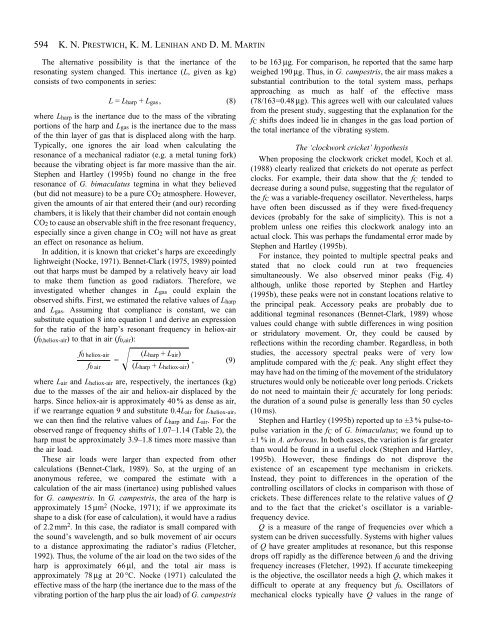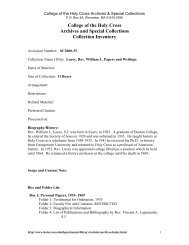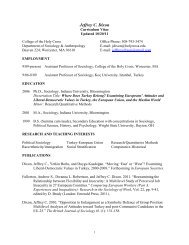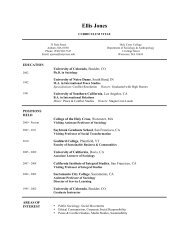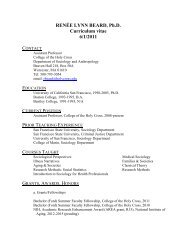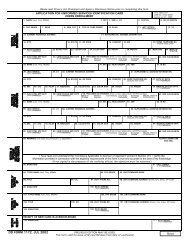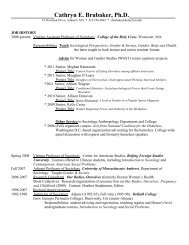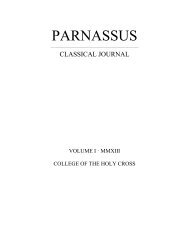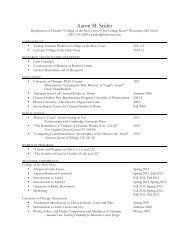Control of frequency in cricket song - The Journal of Experimental ...
Control of frequency in cricket song - The Journal of Experimental ...
Control of frequency in cricket song - The Journal of Experimental ...
You also want an ePaper? Increase the reach of your titles
YUMPU automatically turns print PDFs into web optimized ePapers that Google loves.
594<br />
K. N. PRESTWICH, K. M. LENIHAN AND D. M. MARTIN<br />
<strong>The</strong> alternative possibility is that the <strong>in</strong>ertance <strong>of</strong> the<br />
resonat<strong>in</strong>g system changed. This <strong>in</strong>ertance (L, given as kg)<br />
consists <strong>of</strong> two components <strong>in</strong> series:<br />
L = Lharp + Lgas, (8)<br />
where Lharp is the <strong>in</strong>ertance due to the mass <strong>of</strong> the vibrat<strong>in</strong>g<br />
portions <strong>of</strong> the harp and Lgas is the <strong>in</strong>ertance due to the mass<br />
<strong>of</strong> the th<strong>in</strong> layer <strong>of</strong> gas that is displaced along with the harp.<br />
Typically, one ignores the air load when calculat<strong>in</strong>g the<br />
resonance <strong>of</strong> a mechanical radiator (e.g. a metal tun<strong>in</strong>g fork)<br />
because the vibrat<strong>in</strong>g object is far more massive than the air.<br />
Stephen and Hartley (1995b) found no change <strong>in</strong> the free<br />
resonance <strong>of</strong> G. bimaculatus tegm<strong>in</strong>a <strong>in</strong> what they believed<br />
(but did not measure) to be a pure CO2 atmosphere. However,<br />
given the amounts <strong>of</strong> air that entered their (and our) record<strong>in</strong>g<br />
chambers, it is likely that their chamber did not conta<strong>in</strong> enough<br />
CO2 to cause an observable shift <strong>in</strong> the free resonant <strong>frequency</strong>,<br />
especially s<strong>in</strong>ce a given change <strong>in</strong> CO2 will not have as great<br />
an effect on resonance as helium.<br />
In addition, it is known that <strong>cricket</strong>’s harps are exceed<strong>in</strong>gly<br />
lightweight (Nocke, 1971). Bennet-Clark (1975, 1989) po<strong>in</strong>ted<br />
out that harps must be damped by a relatively heavy air load<br />
to make them function as good radiators. <strong>The</strong>refore, we<br />
<strong>in</strong>vestigated whether changes <strong>in</strong> Lgas could expla<strong>in</strong> the<br />
observed shifts. First, we estimated the relative values <strong>of</strong> Lharp<br />
and Lgas. Assum<strong>in</strong>g that compliance is constant, we can<br />
substitute equation 8 <strong>in</strong>to equation 1 and derive an expression<br />
for the ratio <strong>of</strong> the harp’s resonant <strong>frequency</strong> <strong>in</strong> heliox-air<br />
(f0,heliox-air) to that <strong>in</strong> air (f0,air):<br />
f0 heliox-air<br />
f0 air<br />
<br />
(Lharp + Lair)<br />
(Lharp + Lheliox-air)<br />
= ,<br />
where Lair and Lheliox-air are, respectively, the <strong>in</strong>ertances (kg)<br />
due to the masses <strong>of</strong> the air and heliox-air displaced by the<br />
harps. S<strong>in</strong>ce heliox-air is approximately 40 % as dense as air,<br />
if we rearrange equation 9 and substitute 0.4Lair for Lheliox-air,<br />
we can then f<strong>in</strong>d the relative values <strong>of</strong> Lharp and Lair. For the<br />
observed range <strong>of</strong> <strong>frequency</strong> shifts <strong>of</strong> 1.07–1.14 (Table 2), the<br />
harp must be approximately 3.9–1.8 times more massive than<br />
the air load.<br />
<strong>The</strong>se air loads were larger than expected from other<br />
calculations (Bennet-Clark, 1989). So, at the urg<strong>in</strong>g <strong>of</strong> an<br />
anonymous referee, we compared the estimate with a<br />
calculation <strong>of</strong> the air mass (<strong>in</strong>ertance) us<strong>in</strong>g published values<br />
for G. campestris. In G. campestris, the area <strong>of</strong> the harp is<br />
approximately 15 μm 2 (Nocke, 1971); if we approximate its<br />
shape to a disk (for ease <strong>of</strong> calculation), it would have a radius<br />
<strong>of</strong> 2.2 mm 2 . In this case, the radiator is small compared with<br />
the sound’s wavelength, and so bulk movement <strong>of</strong> air occurs<br />
to a distance approximat<strong>in</strong>g the radiator’s radius (Fletcher,<br />
1992). Thus, the volume <strong>of</strong> the air load on the two sides <strong>of</strong> the<br />
harp is approximately 66 μl, and the total air mass is<br />
approximately 78 μg at 20 °C. Nocke (1971) calculated the<br />
effective mass <strong>of</strong> the harp (the <strong>in</strong>ertance due to the mass <strong>of</strong> the<br />
vibrat<strong>in</strong>g portion <strong>of</strong> the harp plus the air load) <strong>of</strong> G. campestris<br />
(9)<br />
to be 163 μg. For comparison, he reported that the same harp<br />
weighed 190 μg. Thus, <strong>in</strong> G. campestris, the air mass makes a<br />
substantial contribution to the total system mass, perhaps<br />
approach<strong>in</strong>g as much as half <strong>of</strong> the effective mass<br />
(78/163=0.48 μg). This agrees well with our calculated values<br />
from the present study, suggest<strong>in</strong>g that the explanation for the<br />
fC shifts does <strong>in</strong>deed lie <strong>in</strong> changes <strong>in</strong> the gas load portion <strong>of</strong><br />
the total <strong>in</strong>ertance <strong>of</strong> the vibrat<strong>in</strong>g system.<br />
<strong>The</strong> ‘clockwork <strong>cricket</strong>’ hypothesis<br />
When propos<strong>in</strong>g the clockwork <strong>cricket</strong> model, Koch et al.<br />
(1988) clearly realized that <strong>cricket</strong>s do not operate as perfect<br />
clocks. For example, their data show that the fC tended to<br />
decrease dur<strong>in</strong>g a sound pulse, suggest<strong>in</strong>g that the regulator <strong>of</strong><br />
the fC was a variable-<strong>frequency</strong> oscillator. Nevertheless, harps<br />
have <strong>of</strong>ten been discussed as if they were fixed-<strong>frequency</strong><br />
devices (probably for the sake <strong>of</strong> simplicity). This is not a<br />
problem unless one reifies this clockwork analogy <strong>in</strong>to an<br />
actual clock. This was perhaps the fundamental error made by<br />
Stephen and Hartley (1995b).<br />
For <strong>in</strong>stance, they po<strong>in</strong>ted to multiple spectral peaks and<br />
stated that no clock could run at two frequencies<br />
simultaneously. We also observed m<strong>in</strong>or peaks (Fig. 4)<br />
although, unlike those reported by Stephen and Hartley<br />
(1995b), these peaks were not <strong>in</strong> constant locations relative to<br />
the pr<strong>in</strong>cipal peak. Accessory peaks are probably due to<br />
additional tegm<strong>in</strong>al resonances (Bennet-Clark, 1989) whose<br />
values could change with subtle differences <strong>in</strong> w<strong>in</strong>g position<br />
or stridulatory movement. Or, they could be caused by<br />
reflections with<strong>in</strong> the record<strong>in</strong>g chamber. Regardless, <strong>in</strong> both<br />
studies, the accessory spectral peaks were <strong>of</strong> very low<br />
amplitude compared with the fC peak. Any slight effect they<br />
may have had on the tim<strong>in</strong>g <strong>of</strong> the movement <strong>of</strong> the stridulatory<br />
structures would only be noticeable over long periods. Crickets<br />
do not need to ma<strong>in</strong>ta<strong>in</strong> their fC accurately for long periods:<br />
the duration <strong>of</strong> a sound pulse is generally less than 50 cycles<br />
(10 ms).<br />
Stephen and Hartley (1995b) reported up to ±3 % pulse-topulse<br />
variation <strong>in</strong> the fC <strong>of</strong> G. bimaculatus; we found up to<br />
±1 % <strong>in</strong> A. arboreus. In both cases, the variation is far greater<br />
than would be found <strong>in</strong> a useful clock (Stephen and Hartley,<br />
1995b). However, these f<strong>in</strong>d<strong>in</strong>gs do not disprove the<br />
existence <strong>of</strong> an escapement type mechanism <strong>in</strong> <strong>cricket</strong>s.<br />
Instead, they po<strong>in</strong>t to differences <strong>in</strong> the operation <strong>of</strong> the<br />
controll<strong>in</strong>g oscillators <strong>of</strong> clocks <strong>in</strong> comparison with those <strong>of</strong><br />
<strong>cricket</strong>s. <strong>The</strong>se differences relate to the relative values <strong>of</strong> Q<br />
and to the fact that the <strong>cricket</strong>’s oscillator is a variable<strong>frequency</strong><br />
device.<br />
Q is a measure <strong>of</strong> the range <strong>of</strong> frequencies over which a<br />
system can be driven successfully. Systems with higher values<br />
<strong>of</strong> Q have greater amplitudes at resonance, but this response<br />
drops <strong>of</strong>f rapidly as the difference between f0 and the driv<strong>in</strong>g<br />
<strong>frequency</strong> <strong>in</strong>creases (Fletcher, 1992). If accurate timekeep<strong>in</strong>g<br />
is the objective, the oscillator needs a high Q, which makes it<br />
difficult to operate at any <strong>frequency</strong> but f0. Oscillators <strong>of</strong><br />
mechanical clocks typically have Q values <strong>in</strong> the range <strong>of</strong>


